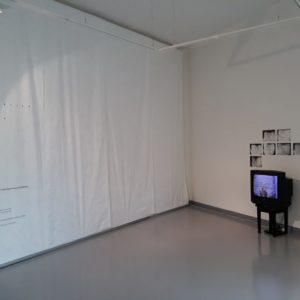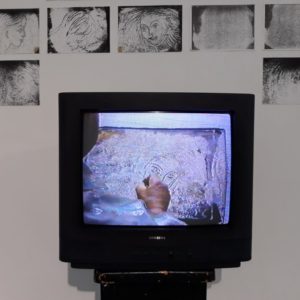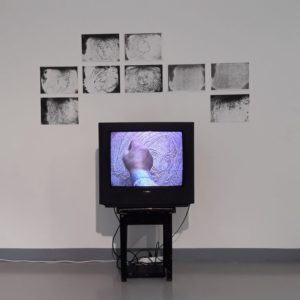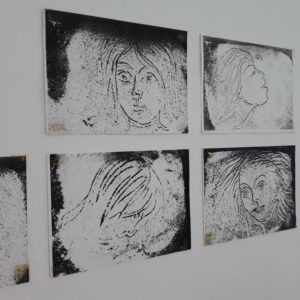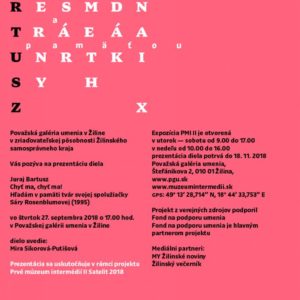Juraj Bartusz – Catch me, Catch me! I am Searching for the Face of Classmate S├íra Rosenblum in My Memory, 1995
Installations Marchieren Marsch! (1993) and Catch me, Catch me! I am Searching for the Face of Classmate S├íra Rosenblum in My Memory (1995) were created by the artist during the 1990’s, when the expansion of the spatial media, mainly installation, characteristically prevailed. At that time, Juraj Bartusz (*1933) also produced several installations that represent the confirmation of the dominance of this medium, but also, in relation to their specific accidence and theme, they are unique models of installation. Their prototype form is anchored in Bartusz’s action art from 1970’s and 1980’s. Alongside the principle that defines the relationship between action and installation (installation is considered to be a form of concentrated action), the gesture of the artist is a very important identifier of these installations. Not as a form-making element of the work (means of its creation) present in other areas of his work but in the installations of Juraj Bartusz, gesture is rather a carrier of┬á meaning. It is an expression of the artist in form of an ironic or critical commentary, or it is a manifestation of resistance. In this notion, the artist’s gesture was also typical for action pieces in which he demasked and ironised nonsensical bureaucratic processes and mechanisms of the control of an individual’s privacy in a socialist society, or used them to express civil and human attitudes to social and later also ecological themes. Along with these, with their system of construction through selection of components and their provenance, the other installations from the first half of the 1990’s such as Back to Europe (1991) or Homeland (1992) declare an affinity to Arte Povera ÔÇô the artist constructs the installations from found materials, he uses natural resources (textile, leather, wood, stone, lining paper, wheat) and components that are tied more closely to the private life of an individual (suitcase, clothing). The installations of this artist also dispose of postmodern narration: they connect the articulation of important contemporary subjects of and individual’s and social existence with references to past experiences. Through this, they create a certain antidote (in meaning and composition) to the later installations produced by the generation of artists of 1990’s (R. Ond├ík, B. Ondrei─Źka, D. Lehock├í, P. Nov├íkov├í-Ondrei─Źkov├í) with a more ‘unmoved’ neo-conceptual code.
The artist created the installation Catch Me, Catch Me! I am Searching for the Face of Classmate S├íra Rosenblum in My Memory (1995) for the exhibition Dream of a Museum? (1995) at the Museum of Art in ┼Żilina. It was preceded by a private performance of the artist, where he would draw the face of his childhood classmate S├íra on a flour poured on a baking sheet from his memory, then shake the sheet in order to erase her face and start repeatedly drawing again, while the drawing process was recorded on a video that later became part of the video installation along with the baking sheets with drawings in flour. In the same year, he┬á presented a performance with the same name at Palmovka Synagogue in Prague. This work therefore connects an action art outcome with tangible artefact ÔÇô medium of sculpture. At the beginning of the 1990’s, the system of composing ÔÇô integration of performance recording/video with the body of an installation was typical for other artists as well (for example J. ┼Żelibsk├í, M.Nitz). Along with the installation Marschieren Marsch! (1993), these pieces are unique contributions to intermedia (installation) art of the 1990’s that reflect the problematics of historical and collective memory, but most of all, they draw attention to the threat of its failure and the consequences. Both works carry a strong personal thread of the artist’s experience of the Second World War. He created the installation Marschiern Marsch! from munition boxes that he found in the gallery loft. The morphology of this work refers to a specific experience: the front line crossed Kamen├şn in Southern Slovakia, the village where he comes from. The cumulation of boxes/suitcases, clothing and the presence of authentic post-explosion Katyuschas (found on the yard after the war) in the installation is an image of how devastatingly the war affected the country, but most of all lives of the many people that were forced to leave their homes. The video installation Catch me, Catch me! I am Searching for the Face of Classmate S├íra Rosenblum in My Memory portrays the growing impossibility/inability to recollect (and remember!) this worldwide trauma. It is a visual metaphor of forgetting portrayed in continual attempts to remember/draw the face of his Jewish classmate S├íra, a playful little girl that did not come to school one day, and the artist never saw her again. Both works correspond with the concept of the current display PM II dedicated to memory ÔÇô a phenomenon that strongly resonates in contemporary art. It also makes one of the paradoxes of current society present: being concerned with the past namely reflects fears of the future. This aspect of contemporary art was also prerecorded in many ways by installations of Juraj Bartusz created during the 1990’s.
Exhibition is supported using public funding by Slovak Arts Council.


